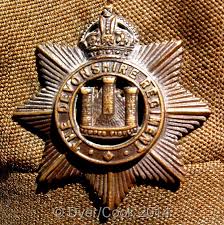
Reginald John Brock

1st Battalion
Private 31270
 | Reginald John Brock |  |
| Devonshire Regiment 1st Battalion Private 31270 | ||
| Killed 6th November 1917 |
Reginald Brock's Parents | ||
|
Reginald’s parents were John Brock and Annie (nee
Dascombe). They were married in 1875 at St Julian’s Church in Wellow, where
Annie had grown up; John Brock’s parents were also living in Wellow at the time
of the marriage, so it is possible that John & Annie grew up together in
the village. John was a coal miner. | ||
The Brock Family |
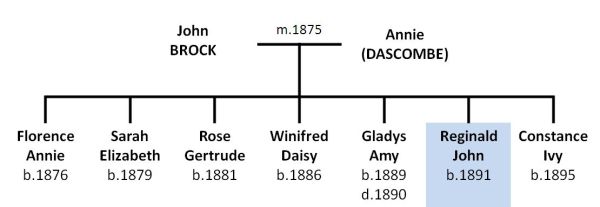 |
|
Reginald Brock‘s mother bore seven children in total and of these Reginald – the sixth child – was the only boy. After their marriage, John & Annie Brock first seem to have lived in the Clutton/Camerton area. According to later census entries, the eldest daughter, Florence, was born in Clutton in 1876. This locality would tie in with (father) John’s work as a miner. By the time the second daughter, Sarah, was born in the summer of 1879, the family had moved to 3 Bellmead Place (then opposite the Green Park Tavern) on the Lower Bristol Road in Bath. By this time, father John had become an engine cleaner on the Somerset & Dorset Joint Railway. This was the bottom rung of the railway career ladder, but a necessary step for anyone whose ambition it was to become an engine driver.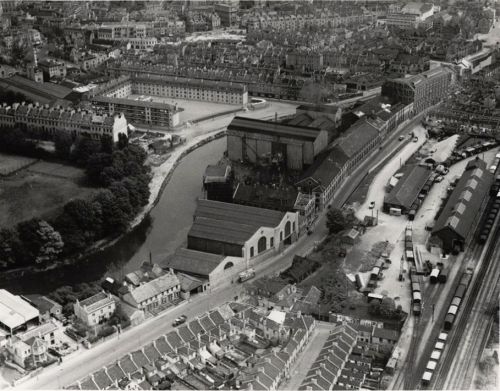 This
aerial view of the Lower Bristol Road area has the Stothert & Pitt
Newark Works in the centre and the GWR goods yard to the right. It is
likely that Bellmead Place,
home to Reginald Brock's parents in the early years of their marriage,
is the terrace of four houses in the lower left portion of the photo.
Note the tram making its way along Lwr Bristol Rd! To clean an engine took an estimated ten man hours, with a team generally working on an engine and the senior members of the team delegating the worst jobs to the more junior cleaners. The most junior cleaners would begin underneath the train, with the wheels and the ‘motion’ (or drive train), then progress to the tender (where coal was stored), rubbing over surfaces with an oily rag. From there one would progress to the smokebox, boiler, firebox and cab sides. Finally, as the most senior person on a cleaning team, one would get to shine bright work, such as the copper-capped chimney, brass safety valve cover, brass name and number plates, brass beading around the wheel splashers and all the copper and brass cab fittings. It was while working in the cab that the senior cleaner was then usually given the opportunity to build up the fire (under supervision) and to learn other rudiments that formed part of the preparation for promotion to work on the footplate. Reginald’s father would probably have been based in the yard at Green Park. He would have come home from work in a very dirty state! |
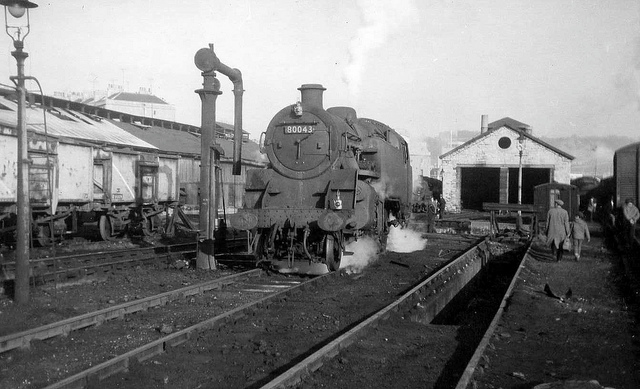 | ||
|
Green Park yard. This photo was taken where Homebase now stands. |
|
The third daughter, Rose, was born in the autumn of 1881 and shortly afterwards the Brock family moved to 23 South View Road, East Twerton. 23 South View Rd From here – at around the time of the birth of Winifred (daughter number 4) in 1886 – they moved to 10 North View, East Twerton and John had made the step up to ‘fireman’. This meant he had left the confines of the Green Park engine sheds and shunting yards and now worked on the footplate, stoking the fires that powered the Somerset & Dorset’s locomotives as they ran out of Bath through Oldfield Park and through Devonshire tunnel to the rest of the company's rail network. 10 North View, East Twerton. Now known as 45 Caledonian Road (note, below, the number 10 is still in evidence in white above the front door!) 1889 saw the birth of Gladys (daughter number 5), but she
died in 1890 before reaching her first birthday. The family had moved again by 1891 to 10 South Avenue and
the census return for that year shows that (father) John had progressed to the status of
engine driver. As such, he was at the ‘top of the tree’ in terms of manual work
on the railway. Engine drivers enjoyed high status and at the end of a long,
hard day’s work on the footplate, if train crews found themselves away from
home, there were accommodation quarters available with separate drinking areas
for the drivers, away from the firemen and brakemen. |
|
10 South Avenue |
|
In 1895 Constance, the last of the children, was born. In 1899, Reginald’s eldest sister Florence married (aged 23) and moved away to Walsall, where the first of her children was born the following year, thus making Reginald an uncle. He became an uncle a second time in 1901 when third-eldest sister Rose (then 20) produced a son 'out of wedlock', which was not the 'done thing' at the time. This led to a curious situation uncovered by the 1901 census,
whereby Rose was one of a pair of servants working for a surgeon and his wife at
46 Combe Park (near the current RUH, but there was no hospital there at this
time), while her one-month-old son Ernest was to be found at Brook Cottage in
Batheaston in a household headed by a Mr & Mrs James Cambourne (baby Ernest
listed as a ‘boarder’!). So far, a family connection between the Cambournes and
Rose Brock has not been found, so this situation seems very unusual. The
Cambournes had not adopted Ernest, however, as he is later shown living with
Rose again. Brook Cottage in Batheaston is in School Lane and James Cambourne
(aged 50 in 1901) was a maltster, so apparently not a wealthy benefactor. The other key event in 1901 for 10-year-old Reginald was the family’s move to 7 Claude Avenue, on the corner with the lane down to Claude Vale. 7 Claude Avenue In 1903, Reginald’s
second-eldest sister Sarah married Robert Horler of Kilmersdon. They
had one
child in Bath and then moved north to Burnley, where later children
were born.
And it is with Sarah & Robert in Burnley that the 1911 census
reveals that
Rose and her son Ernest were reunited and living together. It is easy
to imagine the birth of Ernest having been somehow 'hushed up' in Bath
and the move north engineered to give Rose and Ernest a new start
together. Reginald,
meanwhile, would have left school in around 1903 and there is a gap in what we
know about him in the period before 1911. He is to be found on the 1911 census in
Radstock, living as a ‘boarder’ in Carlingford Terrace, near the railway
station. This is significant as Reginald
seems to be following his father’s career path and is listed as a
‘railway
engine cleaner’. Trains serving the mines of the Somerset coalfields
would probably have returned to Radstock North sheds at night and the
Somerset & Dorset railway would have needed engine cleaners there.
Above: Houses in Carlingford Terrace, Radstock, where Reginald was living in 1911. Back in Bath, the dwindling family unit around parents John & Annie moved several times in quick succession; first to 41 Second Avenue (1912) and then in 1913 to '1 Livingstone Villas' (renumbered in 1914 as 128 Lower Oldfield Park, which is the last house before the railway bridge over to Brougham Hayes). 128 Upper Oldfield Park, where Reginald's parents lived from 1914. |
|
We don't know where Reginald Brock took up residence with his wife Nora. |
Reginald Brock in WW1 | ||
|
1st Battalion, the Devonshire Regiment We know that Reginald Brock was serving with the 1st Battalion of the Devonshire Regiment when he died. The 1st Battalion was formed of ‘regular’ soldiers, i.e. this was a battalion that existed at the outbreak of war rather than being made up of subsequent volunteers. Reginald’s serial number (31270) would appear to date from some time subsequent to the outbreak of war, however. It was common, due to the attrition of war, for units to receive reinforcements from time to time. Sometimes these reinforcements were made in numbers – even the absorption of the remains of other units en masse - but often it was in dribs & drabs. Soldiers took on new serial numbers if they changed regiment. Without Reginald’s military records, it is impossible to be more specific about the details of his service. Even his railway employment records - if we could find them - might give some clue as to when he first joined up and whether this matches the timing of his serial number in the Devonshire Regiment. He was 23 when war broke out and probably a fit young man, given that he worked on the railway. On the other hand, railway workers were sometimes exempted from military service on the basis that they were keeping important infrastructure going at home. We do know that the 1st Battalion of the Devonshires was with 95th Brigade in 5th Division after January 1916 and was involved in the war in 1917 as follows: 1917: The Battle of Vimy Ridge, The Attack on La Coulotte, The Third Battle of the Scarpe, The Battle of Polygon Wood, The Battle of Broodseinde, The Battle of Poelcapelle, The Second Battle of Passchendaele. On 7 September 1917 the 5th Division moved out of the line
for a period of rest before, being sent to Flanders where they were in action
during the Third Battle of Ypres. | ||
Reginald Brock's Death at the Third Battle of Ypres / Passchendaele |
| We don't know specific details of the circumstances surrounding Reginald Brock's death; this requires more research. |
Burial |
|
Reginald Brock is buried at Hooge Crater cemetery, 4 kilometres east of Ypres. Hooge
Chateau and its stables were the scene of very fierce fighting
throughout the First World War. On 31st October 1914, the staff of the
1st and 2nd Divisions were wiped out when the chateau was shelled; from
24th May to 3rd June 1915, the chateau was defended against German
attacks and in July 1915, the crater was made by a mine sprung by the
3rd Division. On 30 July, the Germans took the chateau, and on 9th
August, it and the crater were regained by the 6th Division. The
Germans retook Hooge on 6th June 1916 and on 31st July 1917, the 8th
Division advanced 1.6 km beyond it. It was lost for the last time in
April 1918, but regained by the 9th (Scottish) and 29th Divisions on
28th September. | ||
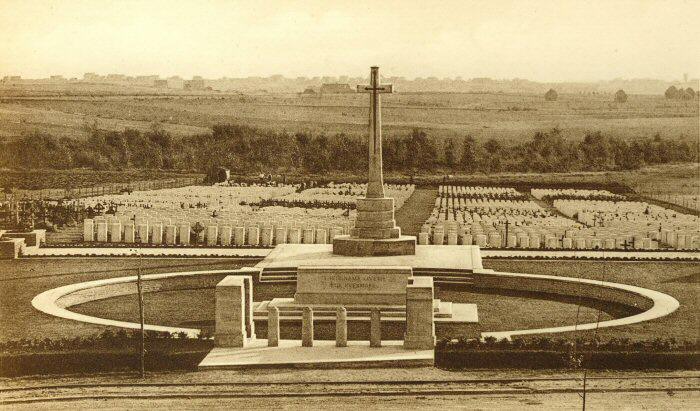 [Image source: www.findagrave.com] | ||
Reginald Brock's grave is among those visited in 2017 by Bathonian Mike Sumsion, who is a regular visitor to the Western Front and who has kindly provided the following photograph of Reginald Brock's headstone: | ||
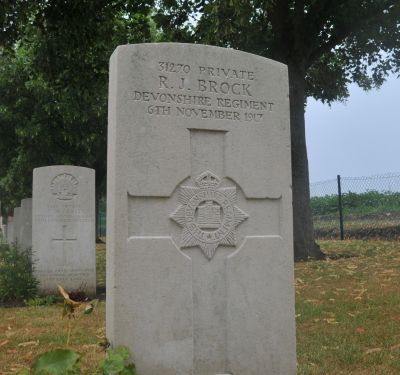 |
Decoration |
|
Reginald Brock would have been in receipt, posthumously, of the British War Medal 1914-18 and the Allied Victory Medal. |
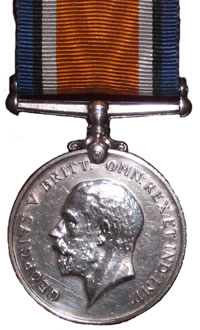 |  | ||
| British War Medal 1914-18 | Allied Victory Medal |
Commemoration | ||
 In addition to his commemoration on the South Twerton School memorial, Reginald Brock is commemorated as follows: | ||
|
Bath War Memorial See separate page for details of the Bath War Memorial. Reginald Brock's inscription: |
 |
|
WW1 Memorial, Devonshire Regiment Chapel, Exeter Cathedral Along with all others who gave their lives in WW1 in service with the Devonshire Regiment, Reginald Brock is commemorated by the Regiment's striking memorial in Exeter Cathedral, as seen in this old Frith postcard: |
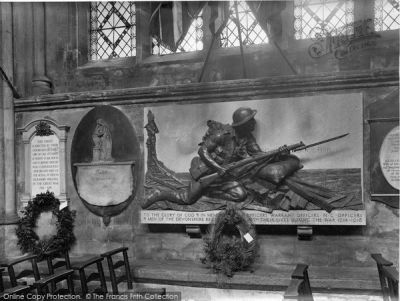 |
|
The Devonshire Regiment's chapel in Exeter Cathedral is also home to the regiment's Book of Remembrance, which includes an inscription for Reginald Brock: |
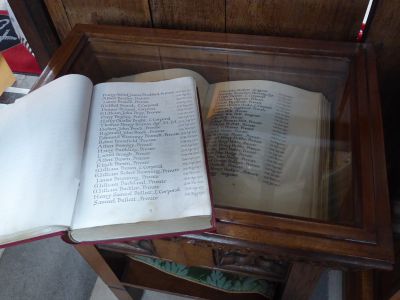  |
Further Information |
After the warIn 1920, Reginald’s widow Nora remarried to William Jones. A newspaper article in February 1933 records the death of Reginald’s father John Brock at his home at 32, St Mark’s Road, aged 79. Of his & Annie’s seven children (Reginald & his siblings), only the three eldest daughters produced offspring. There is another quirk in the family tree, however. Florence (Reginald’s eldest sister), having become Florence Belm upon her marriage in 1899, had three sons up in Staffordshire. The third, George Trevor Belm (born in 1907) was twice married and his second marriage, in 1951, was to a Marjorie Annie Horler. Sarah (Reginald’s second-eldest sister) married 1903 and became Sarah Horler, before moving north to Burnley and having three daughters. The third daughter: Marjory Annie Horler! So George and Marjory were first cousins.Living relativesIt was great to hear from a descendent of Reginald Brock's eldest sister, (Florence) Annie Brock, who became Annie Belm on marriage. Annie's granddaughter Beatrice Gerrie got in touch with more recent family details. We have also been contacted by John Swire, a great-nephew of Reginald Brock through Reginald's sister Sarah Elizabeth (Horler, by marriage). It is very good to know that relatives have found this site and learned about their ancestor's role in WW1. It would be great to hear from any other living relatives of Reginald Brock. We know of descendants of Reginald Brock's siblings as follows:
Please get in touch!If you have any further information on Reginald Brock, or want to suggest corrections / improvements for this page, please use the Contact page to get in touch.All additions and further information will be credited appropriately. |